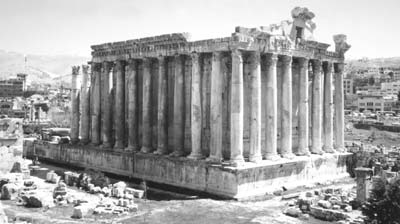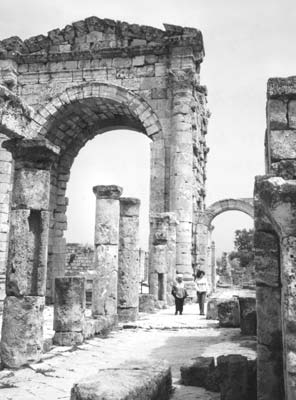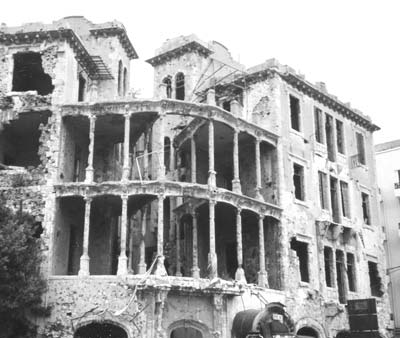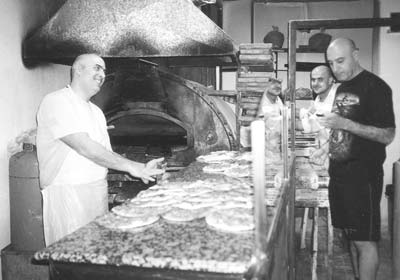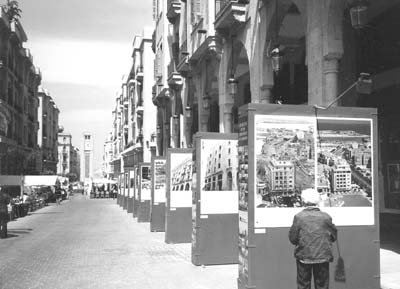Lebanon — brimming with timeless treasures
by Betty and Dick Wood, Seattle, WA
If you have ever thought of visiting Beirut or wanted to see the archaeological ruins of Baalbek, Tyre or Byblos, I would say this is the time to go. The price is right, there are almost no tourists and the local people are very friendly — everyone greets you with “Welcome” and can’t seem to do enough to help you enjoy this most delightful, beautiful country.
Repairing the damage
After many years of civil war (the fighting stopped in 1990), the only damage we noticed in this war-torn country was in Beirut itself, where so many buildings and apartments were still standing in ruins. New construction is making Beirut a more beautiful city (it once was known as the Paris of the Middle East) and has left exposed newfound ruins for all to enjoy.
Lebanon has done a remarkable job of reconstruction, and peace once again seems in order, but the question still remains if the civil war will return to this land of Christians (including Maronites), Druse, Sunni and Shi’a muslims.
We had been anxious to visit Lebanon ever since our visit to Beirut was canceled in September of 1975. We had paid reservations at the old Phoenicia Hotel for the very day it was bombed.
So when we saw that Bestway Tours was offering an 8-day tour called “Lebanon: From Pre-Biblical to Modern,” with departures every Sunday until July 2003, we signed up for a week’s tour departing the first week in April. (Bestway also offers customized tours to fit anyone’s interest and individual needs.)
We flew British Airways from Seattle to Beirut, changing planes in London. We were met at the Beirut airport, purchased visas for about $17 each and were delivered to the 3-star Plaza Hotel (not to be confused with the nearby Crowne Plaza Hotel, which is more expensive), located on a corner of the old-fashioned Hamra Street in downtown Beirut.
Introduction to Beirut
The first morning, we were awakened by the calls of the muezzins (there are many mosques in Beirut). The sun was shining through the balcony window, and it was time to explore this exciting new city.
We went for a short walk up Hamra Street before breakfast. The shopkeepers were busy unlocking the metal shutters and rolling them up. The small paper stands were putting out new stock, and the general noise of the morning traffic was exciting. We checked out the banks and money exchange offices; the going rate for the day was LL1,507 to the dollar.
Breakfast at the hotel was a typical Middle Eastern buffet of juice, fresh fruit, cereal, cheeses of many kinds, olives (green and black), yogurt, croissants and a few of the local pastries.
Getting out and about
Promptly at 9 a.m. a new Mercedes-Benz minivan drove up in front of the hotel and Pauline Daher jumped out and introduced herself as our guide for the next week. Our driver was a young fellow named Mahmoud. Both spoke perfect English, French and Arabic.
We drove south along the coast to visit our first small town, Eshmoun. Here, we walked through the small Phoenician temple complex built for the god Eshmoun. Small and in need of restoration, the marble temple had some interesting carvings.
The area was covered with colorful wildflowers, and the adjoining fields were full of banana trees with bright blue bags around the green stalks of fruit. I never thought of Lebanon as a banana-growing country.
Driving farther south, still along the sea, we arrived at the old seaport city of Sidon. At the harbor is the famous Sea Castle, built by the Crusaders. This famous castle by the sea, jutting out into the harbor, shows the Crusaders’ skill for strengthening their fortress walls by using old Roman columns from nearby ruins. We also visited a mosque, a Greek church and the Khan el Franj, a 17th-century caravanserai where camels and drivers came to sleep, eat and rest. (Today it contains tourist shops.)
Lunch was at a local waterfront restaurant, where we were introduced to a typical Lebanese meal. First, the famous mezzah, or meze, was served, an array of some 10 to 40 appetizers (we had 15) that are best enjoyed with a small glass of arak, the national drink.
Among the many appetizers, our favorite was the baba ghanouj, a dip made of mashed eggplant and sesame seeds. There were also marvelously fresh tabouli salads, stuffed grape leaves and black and green olives grown locally. This was followed by fresh broiled fish and fresh fruit.
Tyre
Later we drove still farther south, almost to the Israeli border, to the highlight of the day: the UNSECO World Heritage Site of Tyre.
Tyre was once the greatest Phoenician city-state and a trading capital of the world. The Tyreans were known as the greatest boat builders of their time, utilizing the forest of cedar trees in the nearby mountains. In the ninth century B.C. they founded the city of Carthage, which dominated the Mediterranean Sea until it was destroyed by the Romans.
Our tour started with a visit to the partially excavated ruins hinting at the city’s early grandeur. One of the most impressive sites mingles Roman columns, Byzantine marble paving and fourth-century mosaics on a spot overlooking the Mediterranean.
We also took a walk through a Roman and Byzantine necropolis, entering under a Roman triumphal arch and passing family tombs and the vast hippodrome. Found under heaps of sand in the 1960s, the hippodrome was so well preserved that it was easy to imagine the chariots of Ben Hur’s day racing around the large arena.
Cedar groves
The next day our minivan took us north along the coast, then into the mountains to visit the famous cedars of Lebanon, the emblem of the republic. In this nation, where Muslims and Christians coexist harmoniously, the road to the forest took us through the Maronite Christian region of Quadi Qadisha (Holy Valley). The spectacular gorge with the silver thread of the Qadisha River below runs past red-roofed villages overhanging sheer mountain precipices.
After a visit to a Maronite monastery, we continued to the village of Becharre, where we visited the Gibran Museum and the Tomb of Khalil Gibran. The internationally famous Lebanese novelist and poet was born and buried there.
Farther into the high mountains, with snow on either side, we arrived at the reserve of the world-famous cedars, known locally as the Cedars of the Lord. The use of these trees goes back in history well over 4,000 years. In Phoenician times they were cut for boat building and sold for export. King Solomon used them to build his temple, and the Egyptians used the resin in their mummification process. In recent times, the British used the wood to build a railway to Palestine.
Baalbek
Baalbek was the highlight of our visit to Lebanon. Some travelers only go to Lebanon to visit this site, usually entering from Syria as it is only 35 miles from Damascus while Beirut is nearly 60 miles away through the mountains. Also, no visa is required when visiting Baalbek from Syria.
We left Beirut early and headed over the mountains, passing some of Lebanon’s most lovely summer resort areas and continuing into the Beqaa Valley.
First, we visited the eighth-century city of Anjar, a World Heritage Site. Located on a hillside overlooking the Beqaa Valley, this site is unusual in itself, as it is the only archaeological site that contains the remains of just one civilization: the Umayyad, the first dynasty of Islam. It looks like a Byzantine city due to the Roman-style architecture, but it is Arabic.
A 25-mile drive from Anjar brought us to the crown jewel of the Middle East, the Roman ruins of Baalbek, with a history that dates back beyond the third millennium B.C.
Baalbek, named after the Phoenician sun god Baal, has always been a sanctuary. Called Heliopolis after its conquest by Alexander the Great, referring to the Greek sun god Helios, the area fell to the Seleucid dynasty after Alexander’s death in 323 B.C. The Romans annexed the area in 64 B.C., and a large city was built surrounded by a stone wall. Only the north gate entrance is visible today.
Inside the walled city are Roman streets, water systems, public buildings, monuments, temples, villas and private homes. In addition, the Romans built a sanctuary, called Qalaa (Arabic for citadel), which I found to be the most interesting part of Baalbek.
After over two hours of wandering and picture taking, we left to have another great Lebanese lunch at the 5-star Grand Hotel Kadri (Brazil Street; phone 961-8-813920 or visit www.kadrihotel.com) at Zahle in the Beqaa Valley. This time there were a full 20 dishes of mezzah plus fish and fresh fruit. What a day!
Back to Beirut plus Byblos
Our next tour was of Beirut, with the highlight being a visit to the newly opened National Museum. Completely destroyed during the civil war, the museum was rebuilt between 1995 and 1999. The art objects were well displayed and labeled and the lighting was very good.
After lunch we toured the war-damaged area of the city, with outdoor posters showing before and after images of buildings and parks, plus newly uncovered ruins. That night we were treated to a bit of the Beirut nightlife with a special dinner, complete with local music and belly dancing.
After a short drive to the north along the coast, we arrived at the charming old seaport town of Byblos, which claims to be the oldest continuously inhabited town in the world.
Located on a hill overlooking the harbor are the ruins of the 7,000-year-old town. Each succeeding civilization built on top of the ruins of the conquered, using what building materials were at hand.
This was very clearly seen in the Crusader castle, where Roman columns and stone blocks were used in its construction. From the top of the castle, one has a wonderful view of the Old City ruins with the sea beyond. Inside the castle is a small but interesting museum.
Entrance fees were required for most every place we visited, but these were included in the tour package.
At the excavation of this ancient site at Byblos, remnants of seven different civilizations can be seen. Once a great Phoenician trading capital, it was here that the first linear alphabet was invented. Besides the Phoenician ruins, there was a small Roman theater and a Roman cathedral, one which was later converted into the church of St. John.
The American University
On our last full day in Beirut we visited the American University, a place we had always wanted to see. The entrance was a short 10-minute walk from our hotel. The campus and gardens are open to the public and are lovely.
We wandered through the campus and eventually arrived at the boulevard promenade at the bottom of the hill along the rocky shoreline. We proceeded along the corniche (as the waterfront drive is called), enjoying the Sunday crowd, stopping along the way to people watch and watching the locals cast for fish.
Arriving at Rocky Point, where there were a number of open-air seafood restaurants, the aroma was enticing, so we picked one of the large ones full of Palm Sunday diners.
The day was sunny and warm, and the sea was blue and sparkling in the sunlight. It was a perfect finish to a wonderful trip. We highly recommend a visit to Lebanon.
The Department of State continues to warn U.S. citizens to consider carefully the risks of travel to Lebanon. For more information, visit http://travel.state.gov/lebanon_warning.html.


